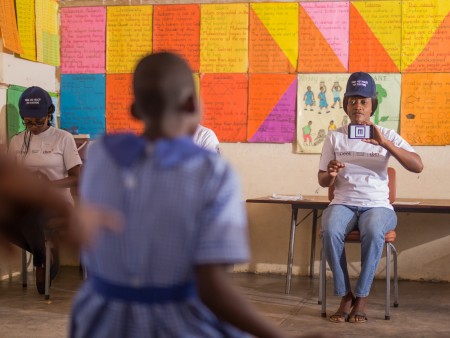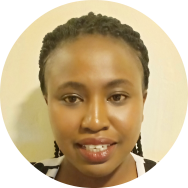
School eye screening using Peek in Zimbabwe
Credit: Zimbabwe Council for the Blind
As the number of people with avoidable vision loss grows around the world, it’s vital we find innovative ways to expand the coverage of eye care services and reach those who need them most.
Peek Vision started life as an academic research project a decade ago, initially developing and testing its smartphone technology and public health tools in collaboration with partners in Kenya, India and Botswana. Today, we work with brilliant international, national and regional partners, including our anchor partner CBM Christian Blind Mission, to deliver school and community eye health programmes in multiple countries.
In sub-Saharan Africa, CBM launched its first Peek-powered programme in Zimbabwe in 2019. Since then, the number of programmes in Zimbabwe has scaled to five, and new CBM-Peek programmes have recently launched in Uganda, Tanzania and Ethiopia, with another planned for Kenya. Peek also recently started working with Vision for a Nation to deliver community eye health programmes in Ghana. In Botswana, the Government, represented by the Ministry of Health & Wellness and supported by the Ministry of Basic Education, is partnering with Peek to roll out a national school eye health programme to help ensure every school-going child with eye problems in the country is identified and treated.
The programmes use the Peek Capture app which incorporates a clinically-validated vision test app within a wider data capture system. The app enables non-specialist users to screen for eye conditions in communities and schools and refer people to care. Through the system, patients referred for follow-up appointments receive automated personalised SMS reminders to encourage attendance. Programme data is reported in real-time within the Peek Admin platform so programme managers can see how services are being utilised, who is or is not reaching treatment, and can respond to any gaps to continuously improve services. Peek tools have been shown to increase both screening coverage and adherence to referral, compared to conventional paper based screening and referral.
In Zimbabwe, it’s estimated that more than 3.3 million people have a vision impairment, and eye conditions are one of the top ten causes of all hospital outpatient visits.
The CBM-Peek programmes in Zimbabwe improve access to quality eye health services, enhance information management and improve awareness and knowledge on inclusive eye health. Coordinated by the CBM Zimbabwe office and implemented by Zimbabwe Council for the Blind, with support from the Ministry of Health and Child Care, Ministry of Primary and Secondary Education and other authorities, the programmes integrate eye health services at the primary health level and strengthen service delivery from the community to specialised services.
The project initially started with school eye health programmes in Harare and Bulawayo. Today, it covers nearly 50 schools in the two provinces and has more recently expanded to three other provinces (Mashonaland West, Masvingo and Manicaland) with community eye health programmes linking 15 facilities at the primary, secondary and tertiary levels.
Using Peek tools means that limited eye health resources can be used more effectively and efficiently. In Mashonaland West, with many people now accessing services more locally at the primary or secondary level through CBM-Peek programmes, the proportion of the provincial hospital caseload that was refractive error has reduced from 18.6% to 4.0%. Most minor cases of allergic conjunctivitis are now treated at the primary and secondary level, whereas they previously made up 29% of the provincial hospital caseload (now 10%).
These changes free up capacity so that the provincial hospital ophthalmologist can focus on more complex eye conditions that need specialised treatment and surgery. For example, cataract cases have increased from 30% to 50% of the hospital case mix, a positive shift reflecting a more appropriate use of the specialist resource as well as greater identification of cases through the community screening.
With the CBM-Peek school eye health programmes in place, the number of children being screened across Harare and Bulawayo increased four-fold from around 10000 annually to more than 40000 in the first year of programmes (pre-COVID).
Despite progress being slowed by the COVID-19 pandemic (which completely halted the school programmes in Harare and Bulawayo), screening continues in the community programmes, with an adapted model to ensure people can still continue to receive services at selected rural clinics and district hospitals, while observing Covid-19 protocols. In total, more than 50000 people have been screened in the CBM-Peek Zimbabwe school and community eye health programmes to date, and over 8000 have received surgery, medication or spectacles to improve their sight.
With the support and vision of our remarkable partners, in the coming months and years we will continue to support the programmes in Zimbabwe and plan to scale-up programmes in the wider African region, to improve eye health care coverage and equity so that more people get the treatment they need.
This article was originally published on the International Agency for the Prevention of Blindness (IAPB) website.

About the author: Grace Mwangi is Programme Management Lead for Peek Programmes in Zimbabwe and Tanzania. She is an experienced Public Health professional with over six years’ experience in designing, implementing and managing eye health projects across sub-Saharan Africa.